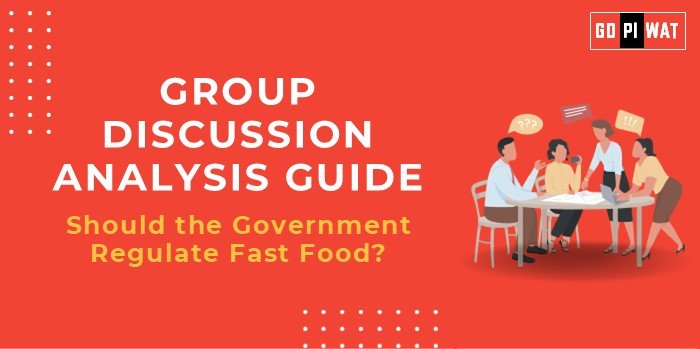📋 Group Discussion Analysis Guide
🌐 Introduction
Topic: “Should the government regulate fast food to combat obesity?”
🍔 Opening Context: The global obesity crisis has reached critical levels, with fast food consumption identified as a key contributor. Governments worldwide are considering regulations on the fast-food industry to address rising health concerns and reduce obesity rates.
📜 Topic Background: Fast food is often high in fats, sugars, and calories, contributing to unhealthy weight gain and obesity. This further leads to diseases such as diabetes and heart disease. Various countries have initiated policies to limit or regulate fast food sales, especially among children.
📊 Quick Facts and Key Statistics
- 🌍 Global Obesity Rates: Over 1 billion adults worldwide are classified as obese, with numbers expected to rise (World Health Organization, 2023).
- 💰 Health Costs: Obesity-related diseases cost healthcare systems $1.4 trillion globally each year (OECD, 2023).
- 🍟 Fast Food Consumption: The average American eats fast food at least three times a week, with similar trends observed in urban populations worldwide.
- ⚖️ Government Action: Countries like the UK and Mexico have implemented taxes on sugary drinks and foods to reduce consumption.
🎭 Stakeholders and Their Roles
- 🏛️ Government and Health Agencies: Implement policies, conduct awareness campaigns, and regulate advertising and food quality.
- 🍔 Fast Food Industry: Produces and markets fast foods; may oppose regulations that impact profits but can adapt by offering healthier options.
- 💡 Public Health Organizations: Advocate for healthier eating, research the impact of fast food on health, and support regulations.
- 👨👩👧👦 Consumers: Affected by both obesity and government policies; play a role in choosing healthier food options.
🏆 Achievements and ⚠️ Challenges
Achievements
- ✔️ Regulatory Successes: The UK sugar tax led to a 28% reduction in sugary drink purchases.
- 📢 Public Awareness Campaigns: Increased knowledge about fast food risks has led to slight reductions in consumption in some demographics.
- 🍏 Industry Adaptation: Some companies have introduced healthier menu items due to consumer demand.
Challenges
- 💸 Accessibility and Affordability: Healthy food is often more expensive, making fast food an economical choice.
- ⚔️ Resistance from Industry: Fast food companies may resist regulations that threaten profits, as seen in industry responses to sugar taxes.
- 🌐 Global Comparisons: In countries like Mexico, sugar taxes have reduced consumption but have faced challenges in low-income areas.
🗣️ Structured Arguments for Discussion
Supporting Stance: “Government regulation on fast food is necessary to control obesity rates, as evidence suggests that regulatory measures like taxes can reduce consumption.”
Opposing Stance: “Regulating fast food infringes on personal choice and may not effectively curb obesity, as people can shift to other unhealthy foods.”
Balanced Perspective: “While government regulation can guide healthier choices, it must be paired with public education and affordable healthy food options for effectiveness.”
📋 Effective Discussion Approaches
- 📊 Opening Approaches:
- Statistics-Based Opening: “With obesity rates escalating globally, should governments step in to regulate fast food consumption to promote public health?”
- Impact Comparison: “Many governments have successfully reduced smoking rates through regulation; could similar measures work for fast food?”
- 🤔 Counter-Argument Handling: Acknowledge fast food’s affordability appeal, then propose subsidizing healthy foods as an alternative solution.
🛠️ Strategic Analysis of Strengths and Weaknesses
- 🔑 Strengths: Can reduce healthcare costs; encourages healthier options from the industry.
- ⚡ Weaknesses: May face resistance; potentially limits personal freedom.
- 🌟 Opportunities: Promotes healthier lifestyles, especially in younger demographics.
- ⚠️ Threats: Could impact low-income families disproportionately if not managed carefully.
📚 Connecting with B-School Applications
- 💼 Real-World Applications: Possible projects in policy-making, public health analysis, and consumer behavior studies.
- 🎓 Sample Interview Questions:
- “Do you think government regulation is the most effective way to combat obesity?”
- “How would you balance industry freedom with public health needs?”
- 💡 Insights for B-School Students: Consider regulatory impacts on consumer choices, marketing strategies, and corporate social responsibility.


